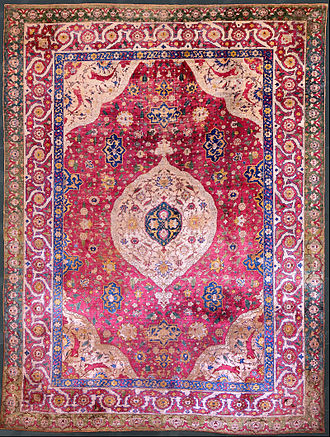ID :
337191
Tue, 08/05/2014 - 12:05
Auther :
Shortlink :
https://oananews.org//node/337191
The shortlink copeid
Official: Annual Carpet Exports To Reach $400m This Year

Hamedan, Aug 5, IRNA – March 20, 2014 to March 20, 2015 carpet exports income of Iran is expected to increase up to 400 million US dollars, Head of National Iranian Carpet Center Hamid Karegar said here Monday night.
ˈLast (Iranian) year (March 20, 2013- March 20, 2014) despite existence of sanctions countryˈs total income from carpet exports was $314 million, but during first 3 months of this year we observed an almost 25% increase in carpet exports compared to last year and we predict by the year-end (March 20, 2015) Iranˈs income from carper exports will reach $400 million,ˈ he said, addressing the opening ceremony of Hamedan Hand-woven Carpets Exhibition.
Karegar said that there is a rumor in the society the Chinese have copied the Iranian carpet designs and captured the Iranian carpetsˈ market in the world, but that is a wrong belief, since China is no longer a producer of hand-woven carpets and is on the contrary one of the best markets for Iranian carpets today.
ˈChina has increased its carpet imports from Iran by %155 in terms of weigh compared with last year and is now the 5th top importer of the Iranian carpets,ˈ he reiterated, adding that there is an Iranian Hand-woven Carpets Exhibition in China this week.
Elaborating on the National Iranian Carpet Centerˈs plans, he said, ˈProviding appropriate atmospheres for the carper weavers, using fine quality weaving frames, and provision of high quality raw material are among the measures to be adopted to achieve high quality carpetsˈ.
The head of National Iranian Carpet Center said that the Iranian carper weavers now have good health insurance coverage, but the retirement and unemployment insurance coverage need to be added to that to provide peace of mind for the weavers.
Karegar said that the establishment of a hand-woven carpet fraction in the Iranian Parliament would facilitate the resolving of the problems associated with carpet weaving, asking the Parliament members to pursue the establishment of such a parliamentary fraction.
ˈThe hand-woven carpets are reliable, noticeable assets in (Iranˈs proposed) resistance economy field and the carpet industry is a business that can be set up relying on a minimum investment,ˈ he added.
Deputy Hamedan Governor for Planning Affairs Khosrow Sameri, too, said that there are now 50,000 hand-woven carpet weavers in the province that have the carpet weaving expertise licenses, adding that Hamedan province produces some 53,000 square meters of carpets annually.
Sameri said that the provincial officials are ready for establishment of transregional and new carpet markets, adding that the job creating aspect of this industry is the top priority for provincial officials.
The 9th Specialized Hand-woven Carpets Exhibition was opened in the Permanent International Fairs Ground of Hamedan on Monday August 4 and will be open for the enthusiasts till Sunday August 10.
According to current statistics, some one million Iranians are either directly, or on part time basis involved in hand-woven carpet industry throughout the country today.
The Persian carpet or Persian rug is an essential part of Persian art and culture.
Carpet-weaving is undoubtedly one of the most distinguished manifestations of Persian culture and art, and dates back to ancient Persia. In 2008, Iran’s export of hand-woven carpets was $420 million or 30% of the worldˈs market.
There is an estimated population of 1.2 million weavers in Iran producing carpets for domestic markets and international exports. Iran exports carpets to more than 100 countries, as hand-woven rugs are one of its main non-oil export items.
The country produces about five million square meters of carpets annually—80 percent of which are sold in international markets. In recent times Iranian carpets have come under fierce competition from other countries producing reproductions of the original Iranian designs as well as cheaper substitutes.
The designs of Persian carpets are copied by weavers from other countries as well. Iran is also the worldˈs largest producer and exporter of handmade carpets, producing three quarters of the worldˈs total output. Though in recent times, this ancient tradition has come under stiff competition from machine-made products. Iran is also the maker of the largest handmade carpet in history, measuring 5,624.9 square meters.
Persian carpets can be divided into three groups; Farsh / Qāli (sized anything greater than 6×4 feet), Qālicheh (meaning ˈsmall rug), sized 6×4 feet and smaller), and nomadic carpets known as Gelim (including Zilus, meaning ˈrough carpetsˈ)./end





